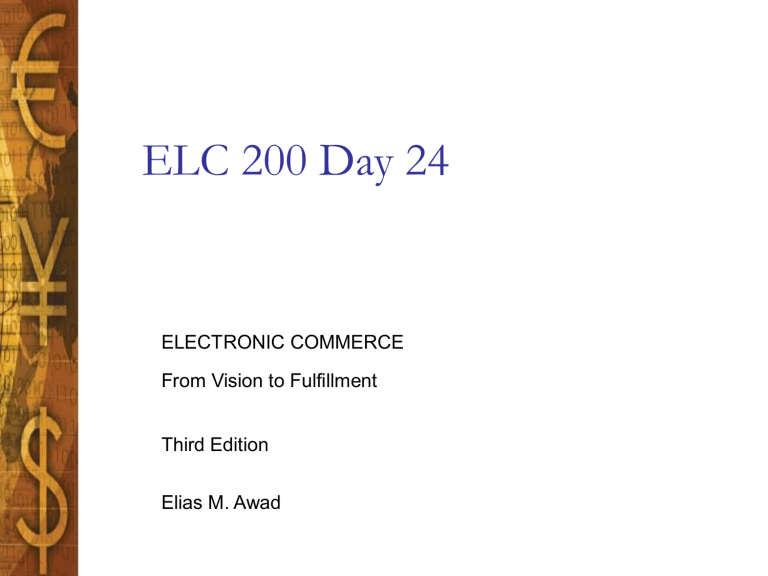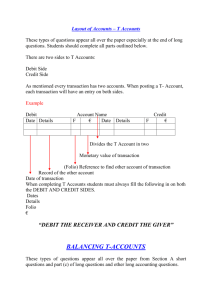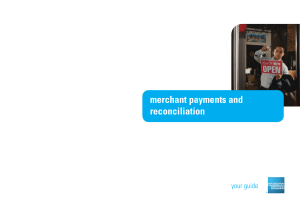elc200day24

ELC 200 Day 24
ELECTRONIC COMMERCE
From Vision to Fulfillment
Third Edition
Elias M. Awad
End of days? (subject to change)
• Dec 10
– Chap 15 Getting the
Money
• Dec 13
– Quiz 4
– Chapters 12-16
– 25 M/C questions
– Optional assignment 9 due
• Dec 18 (Tuesday)
– 10 AM eCommerce frameworks due
– Student presentations
• 5 Mins each
Agenda
• Assignment 8 Corrected
– 5 A’s, 6 B’s, 1 C, 2 D’s, 2 F’s and 2 non-submits
• Assignment 9 Posted
– Due Dec 13
– Optional replace lowest assignment grade.
• Quiz 4 next class
– Chapters 12-16
– 25 M/C questions
– Extra Credit on next quiz
• First example of paper money (world)
• First example of paper money in USA
• First Digital Cash Company and its founder
• Ecommerce Initiative Frameworks
– Guidelines
– Due DEC 18 @ 10 AM
• Discussion on Getting the Money
Getting the Money
ELECTRONIC COMMERCE
From Vision to Fulfillment
Third Edition
Elias M. Awad
The focus of this chapter is on several learning objectives
• Real-world and electronic cash and their unique features and uses
• The key requirements for Internet-based payments
• The many ways people pay to purchase goods and services on the Internet
• Business-to-business methods of payment
• Paying for goods and services via the mobile phone
• Issues and implications behind electronic money transactions and payments
BRIEF HISTORY OF MONEY
• Barter
• Medium of Exchange
– Tokens
– Notational Money
– Credit System
Real-World Cash
• Money
– Medium of exchange to simplify transactions
– Standard of value
– Store of value to facilitate the concept of saving
• Cash continues to be the most widely used form of payment
– Convenience
– Wide acceptance
– Anonymity
– No cost of use
– No audit trail
Electronic Money (E-Money)
• E-money is an electronic medium for making payments
– Credit cards
– Smart cards
– Debit cards
– Electronic funds transfer
• Identified e-money (digital cash) is a notational money system that generates an audit trail and can be traced
• Anonymous e-money is a notational money system that cannot be traced
• Types of e-money
– Identified and online (+I+L)
– Identified and off-line (+I-L)
– Anonymous and online (-I+L)
– Anonymous and off-line (-I-L)
Properties Of Money
• Online/offline represents risk
– Online is on the spot validated transaction
– An offline transactions is validated later
• Identified and Online (+I+L)
– Credit cards and debit cards
• Identified and Offline (+I-L)
– Checks, Money orders
• Anonymous and Online (-I+L)
– Cash payments
• Anonymous and Offline (-I-L)
– Electronic cash (but not real cash)
ACID TEST
• Atomicity
– All or nothing
• Consistency
– All agree
• Isolation
– Doesn’t effect other transactions
• Durability
– Can go back to previous state (i.e. reversible)
ICES TEST
• Interoperability
– Ability to move between system
• Conservation
– Temporal consistency and durability
• Economy
– Cost of use
• Scalability
– Multiple users
TRANSACTION
PROPERTIES
Cash Y Y Y Y Y Y N Y Y
Check N Y Y N Y N Y N Y
Credit Card N N Y N Y N N Y
Postal
Money Order
?
?
?
?
?
?
?
?
?
Requirements for Internetbased Payments
• Electronic payments are financial transactions made without the use of paper documents such as cash or checks
• Internet-based Payment Systems Models
– Electronic currency is the network equivalent of cash
– Credit and debit cards are the electronic equivalent of checks
• Properties important to an electronic payment system:
– Acceptability
– Ease of integration
– Customer base
– Ease of use and ease of access
ELECTRONIC
TRANSACTION SYSTEMS
• CyberCash
– http://www.cybercash.com/
– Bought by Verisign, then by PayPal
• Netbill
– http://www.netbill.com/
– No longer active
• First Virtual
– No longer in internet payment systems
• Paypal
– www.paypal.com
Active payment systems (2007)
• http://www.paysimple.com/
• http://www.mypaynet.com
• http://checkout.google.com/sell?promo=sha2
• http://www.authorize.net/
• http://www.worldpay.com/
• https://www.paypal.com/
How PayPal Works
Secure Internet Credit Card Payment
How Would You Like to Pay?
• Types of electronic payment media
– Trusted third-party type
– Notational fund transfer-related type
– Digital cash or electronic money
Paying with Credit Cards
• A merchant must accept credit cards
• You must first open a merchant account with your bank
• Charges the merchant pays for online transactions are equivalent to the charges for phoning in the transaction
• The Web merchant needs some form of secure and encrypted line, usually (SSL)
• The merchant needs a shopping cart program that allows users to collect their purchases
Classical Flow of a SET Transaction
Debit Cards
• Look exactly like credits cards, except they directly tap your checking account every time you make a purchase or a withdrawal
• Using a debit card frees you from having to carry cash or a checkbook
• Debit cards are more readily accepted by merchants than are checks
• It is generally easier to get a debit card than a credit card
• Use of PIN creates identified & online transaction
– Hard to dispute!
Debit Cards
( Cont’d )
• Returned debit card purchases are treated just like returns for items purchased by cash or check
• The debit card is a quick pay now process
• Using a debit card may mean less protection for items that are never delivered, for defective items, or for items that were mis-represented
• Cardholders might overspend their limit before anyone finds out
Smart Cards
• Uses for Smart Cards
– Provides users with the ability to make a purchase
– Holds cash, ID information, and a key to a house or an office
– Three categories of applications
• Authenticate an individual’s claim of personal identification
• Authorization for things like drug prescription fulfillment and voting purposes
• Transaction processing
– Provides encryption and decryption of messages to ensure security, integrity, and confidentiality
– Acts as a carrier of value
Smart Card Applications
• Government
• Identification
• Health care
• Loyalty
• Telecommunications
• Transportation
• Financial
DigiCash, E-Cash and E-Wallet
• Digital cash leaves no audit trail
• From a regulatory point of view, digital cash is not any different from any other kind of electronic financial payment medium
• PayPal.com combines e-mail and the credit card network to send real cash
• E-wallet is an electronic payment system that operates like a carrier of e-cash and information in the same way a real-world wallet functions
• Amazon.com’s 1-Click system, http://www.Amazon.com
Electronic Funds Transfer and Automated
Clearinghouse
• Electronic fund transfer (EFT) is a computerbased system that facilitates the transfer of money or the processing of financial transactions between two financial institutions
• Automated Clearinghouse (ACH) is where bank transactions, involving more than one institution, are routed to debit and credit the correct accounts
ACH - Generic Life Cycle of Check
Clearance
Check Numbers
Mobile-specific
Transaction Architecture
General Guide to E-Payment
• Use a secure Web browser
• Read the Web site’s privacy policy carefully
• Determine the merchant’s refund policies in advance of the final purchase
• Investigate the trustworthiness of the merchant before you initiate a purchase
• Keep a record of all online transactions and check e-mail and other contacts regularly
• Review your credit card statements line-by-line to ensure authenticity
Issues Regarding Electronic Payment
Methods and Methodologies
• Consumer needs
• Corporate processes
• Corporate strategy
• Regulation of competition
• Economic and social processes



